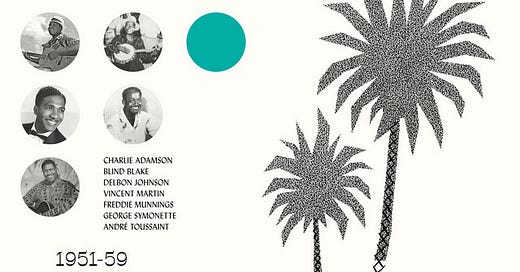Genre of the Day - Goombay
Album of the Day - Goombay (Music from Bahamas) by Various Artists (2018)
July 24, 2024
I love self-referential genres. I need to make a playlist of all the songs I’ve encountered that directly reference the genre at hand from “Honky-Tonkin’” to “Bandari” and of course, yesterday’s ‘plugg’ producer tag instantly branding beats, but that’s a project for a later date. Today’s album references goombay not once, but twice in song titles. Goombay is at its most basic the name of a large membranophone drum used in the Bahamas, derived from the Kongo word nkombi for a similar drum. It’s a potent word. As the center of the nation’s music and as a vital cultural facet, it captures the Bahamas’ unique cultural essence. Goombay is the sound of the Bahamas asserting its voice in the busy chatter of so many renowned forms of Caribbean music, prodding listeners to turn their eyes away from the brilliantly azure waters and tune their ears towards the music.
Derived from the drum and accompanying dances, goombay as a genre represents the curious, complex phenomenon of cultural expression in a tourism-driven economy, where outsiders have long outnumbered fellow countrymen in the audiences of Nassau’s clubs. Today, the Bahamas reports eight million annual visitors, compared to a population of just 400,000 across the dozens of islands and quays. Since the moment Christopher Columbus landed in the Bahamas as his expedition’s first encounter with the Americas, the nation has been overrun with visitors. The country has just fifty years of independence under its (sand)belt, as the islands were under British rule until 1973. The construction of goombay drums reflects the balance of native and outsider presences in the islands—certain makeshift goombay drums breathe musical life into used oil barrels as the base of the drum.
Goombay was the product of innovation, though with precedent. Enslaved communities forcibly taken to the islands, mostly from West Africa, forged communal strength through the rare occasions allowing musical celebration. Just as in jongo, the first step was to craft drums similar to those left behind. Craftsmen stretched goat skin over the top of discarded barrels used to contain herring, flour barrels, or other suitable containers, a tradition noted by 1790. It quickly became the staple in Junkanoo, the Bahamas’ Boxing Day celebrations that arguably outdo other well-known Caribbean festivals in sheer color and vibrancy. Goombay drums and rhythms have remained the distinction of Bahamian musical culture, providing the base for celebratory occasions.
The records in this compilation date from the 1950s as calypso became the most recognized Caribbean genre thanks to a Harry Belafonte-induced craze, before reggae blew it out of the crystal-clear Gulf water. It’s the sound of Bahamian artists balancing traditional folk expression with the need to participate in the growing tourism industry, which now contributes to 70% of the country’s GDP, and appease foreign audiences’ taste for exotica flair. Goombay as a genre doesn’t have a lot of elements besides the presence of the goombay drum symbolically key to Bahamian identity, so these compositions’ sonic scaffolding come in the form of calypso and jazz influence. “Goombay Rock” and “Goombay” are both metanarratives appreciating the goombay, in part lyrically pointing to the drums’ importance (“The drum shakes the devil out of you!”) while infusing joy through jaunty piano. Goombay music at this time filled the halls of both the clubs of swanky Nassau hotels as well as the ‘over-the-hill’ clubs attended by a more equal number of Afro-Bahamian natives and tourists. Musicians accounted for local tastes by testing out new ditties in the over-the-hill clubs before firing them up at the more tourist-heavy locales. That being said, many of these songs directly reference tourism and basic visions of island life, from the astounding “Come to the Caribbean” to the more winking “Nassau Meringue” and a fantastical ode to coconuts (“Coconut Woman.”) It’s impressive, still, that the grooves of this music made in such a double bind hold up in joyful ambience. Though tourists come and go, goombay and its power is forever.
Unrelated but uncanny: two of the last songs on this album are called Camilla, which is pronounced closer to Kamala in the vocal delivery, and Uncle Joe. Besides the goombay, perhaps these ‘50s singers possessed a clairvoyance in American politics.







